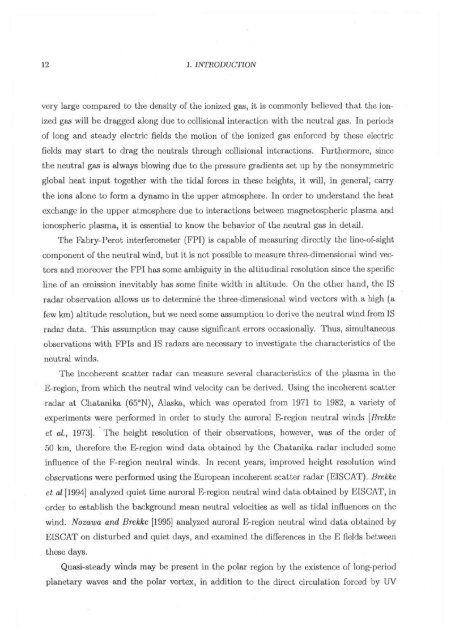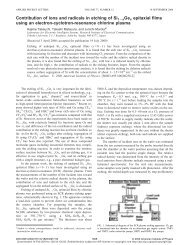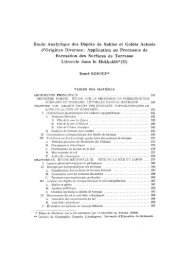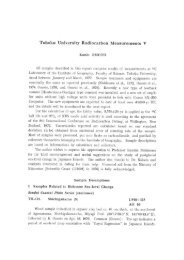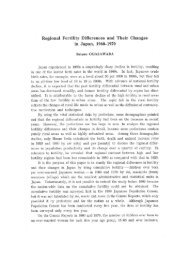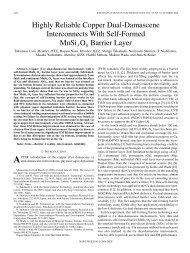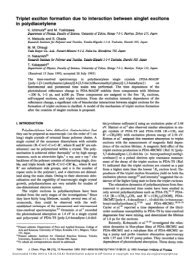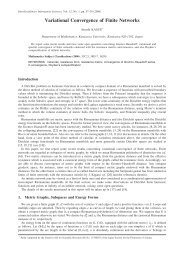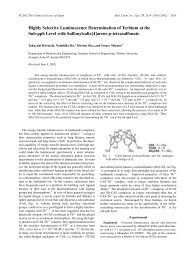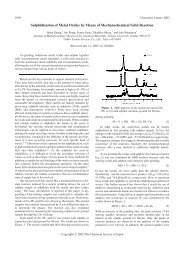MgE71241:1attf:3(t At-- 0 -3 5t5M I:. N1144±TitoD riziMinliJ VAT .9f 1 ...
MgE71241:1attf:3(t At-- 0 -3 5t5M I:. N1144±TitoD riziMinliJ VAT .9f 1 ...
MgE71241:1attf:3(t At-- 0 -3 5t5M I:. N1144±TitoD riziMinliJ VAT .9f 1 ...
You also want an ePaper? Increase the reach of your titles
YUMPU automatically turns print PDFs into web optimized ePapers that Google loves.
12 1. INTRODUCTION<br />
very large compared to the density of the ionized gas, it is commonly believed that the ion-<br />
ized gas will be dragged along due to collisional interaction with the neutral gas. In periods<br />
of long and steady electric fields the motion of the ionized gas enforced by these electric<br />
fields may start to drag the neutrals through collisional interactions. Furthermore, since<br />
the neutral gas is always blowing due to the pressure gradients set up by the nonsymmetric<br />
global heat input together with the tidal forces in these heights, it will, in general; carry<br />
the ions alone to form a dynamo in the upper atmosphere. In order to understand the heat<br />
exchange in the upper atmosphere due to interactions between magnetospheric plasma and<br />
ionospheric plasma, it is essential to know the behavior of the neutral gas in detail.<br />
The Fabry-Perot interferometer (FPI) is capable of measuring directly the line-of-sight<br />
component of the neutral wind, but it is not possible to measure three-dimensional wind vec-<br />
tors and moreover the FPI has some ambiguity in the altitudinal resolution since the specific<br />
line of an emission inevitably has some finite width in altitude. On the other hand, the IS<br />
radar observation allows us to determine the three-dimensional wind vectors with a high (a<br />
few km) altitude resolution, but we need some assumption to derive the neutral wind from IS<br />
radar data. This assumption may cause significant errors occasionally. Thus, simultaneous<br />
observations with FPIs and IS radars are necessary to investigate the characteristics of the<br />
neutral winds.<br />
The incoherent scatter radar can measure several characteristics of the plasma in the<br />
E-region, from which the neutral wind velocity can be derived. Using the incoherent scatter<br />
radar at Chatanika (65°N), Alaska, which was operated from 1971 to 1982, a variety of<br />
experiments were performed in order to study the auroral E-region neutral winds [Brekke<br />
et at., 1973]. The height resolution of their observations, however, was of the order of<br />
50 km, therefore the E-region wind data obtained by the Chatanika radar included some<br />
influence of the F-region neutral winds. In recent years, improved height resolution wind<br />
observations were performed using the European incoherent scatter radar (EISCAT). Brekke<br />
et at [1994] analyzed quiet time auroral E-region neutral wind data obtained by EISCAT, in<br />
order to establish the background mean neutral velocities as well as tidal influences on the<br />
wind. Nozawa and Brekke 11995] analyzed auroral I1-region neutral wind data obtained by<br />
EISCAT on disturbed and quiet days, and examined the differences in the E fields between<br />
these days.<br />
Quasi-steady winds may be present in the polar region by the existence of long-period<br />
planetary waves and the polar vortex, in addition to the direct circulation forced by UV


